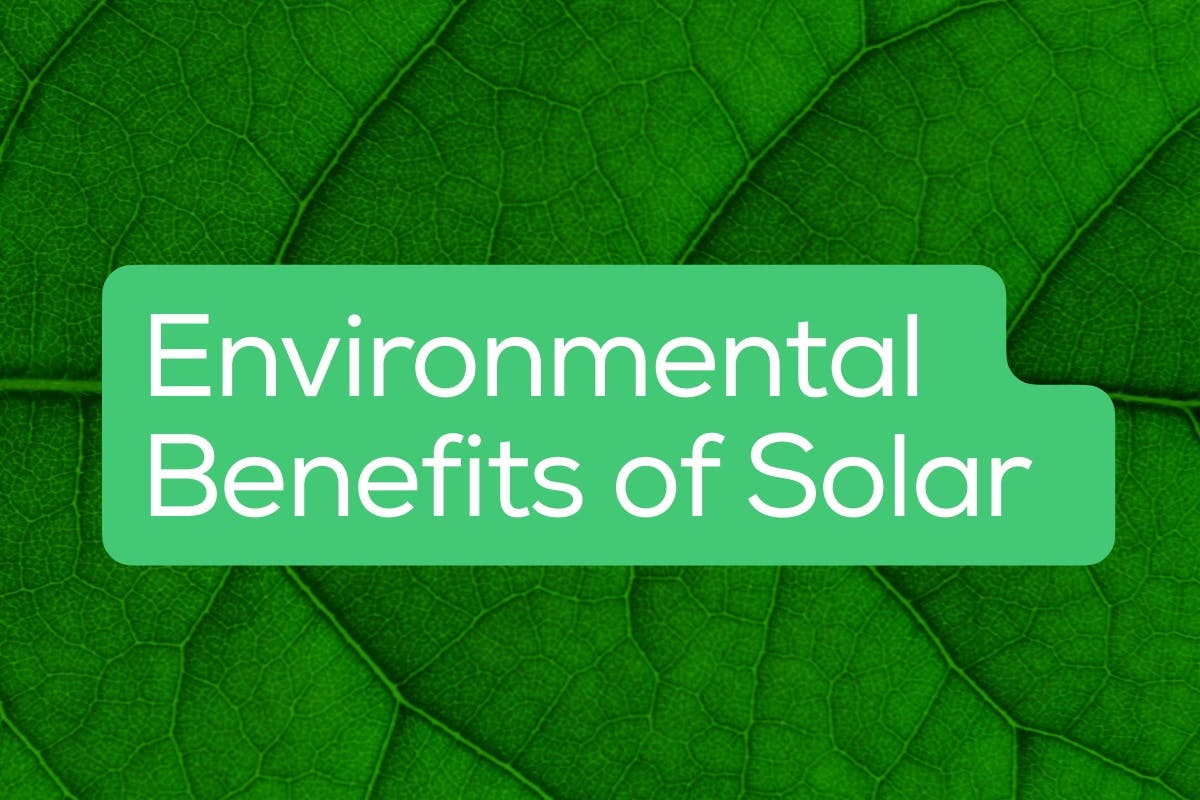The Health and Environmental Benefits of Solar Energy
Last edited

Author
Andrew Blok
Electrification and Solar Writer and Editor

Editor
Ryan Barnett
SVP, Policy & New Market Development

There’s no doubt that climate change is happening, and human activity is largely to blame. Many of the activities that create the globe-warming greenhouse gases come with other health risks, too. So, switching to renewable energy, like solar power, could not only help us avoid the worst parts of climate change but also improve the health of people and the environment.
So what health and environmental benefits can solar panels and other forms of renewable energy deliver? We’ll highlight a few of the additional positives of switching our energy system from one based on fossil fuels to one based on clean electricity.
See how much you can save by going solar with Palmetto
Health and Environmental Benefits of Using Solar Energy
Departures from combustion-based power sources can create a positive change for the planet and its inhabitants (hint: that’s us). Here are four key environmental benefits of solar energy.
Reduced air pollution
Preliminary data from the US Energy Information Administration, shows that over 60% of the electricity produced in the United States in 2023 was generated by carbon-emitting fossil fuels. At the same time, 21% of US electricity was generated from renewable resources such as wind, hydro, and solar.
Here, a national shift to solar and other green energies can dramatically reduce local carbon dioxide (CO2), nitrous oxide (N₂O), sulfur dioxide (SO₂), and particulate matter emissions. In an analysis conducted by the National Renewable Energy Laboratory (NREL), widespread electrification and decarbonization of electricity could save $1.7 trillion in avoided climate damage and improved air quality.
The US Environmental Protection Agency says that fossil fuel power plants are the country’s largest stationary source of nitrogen oxides and sulfur dioxides and a large source of mercury. Those pollutants are known to have negative effects on human health.
Solar panels generate electricity without pollution.
Fights climate change
Carbon emissions and other greenhouse gasses are major contributors to the increase in global temperature, known as global warming. Although some greenhouse gas emissions may be generated during manufacturing and transportation, solar photovoltaic panels do not produce any greenhouse gasses while generating electricity, making them a good source of clean energy.
Every kilowatt-hour of electricity produced by a solar panel, rather than a fossil fuel like natural gas, can reduce the end user’s carbon footprint. Widespread adoption of solar panels and other clean energy sources can reduce greenhouse gases in the atmosphere and help curb the effects of climate change from global warming.
Reduces resource stress
It is easy to forget that there is a finite amount of fossil fuels available, and once they are gone, we can't get them back (at least not for millions of years). This means that switching to renewable energy isn't just better for the environment; it’s necessary to continue powering our world for future generations.
Alongside a finite amount of fossil fuels as an energy source, water is another critical resource to consider for the long-term health of the planet. While the production of solar panels does use some water (especially in the extraction and processing of minerals), the process can use significantly less water than traditional electricity sources.
Improves global health
Beyond its effects on global warming, carbon emissions can have a serious impact on human health, affecting vital organs, such as the heart and lungs. Cleaner air can decrease the risks of heart disease, asthma attacks, and premature deaths, which are major health issues globally.
The EPA found that amendments in 1990 to the Clean Air Act were expected to avoid more than 230,000 premature deaths thanks to reduced air pollution from cars, power plants, and more.
See how much you can save by going solar with Palmetto
Environmental Challenges of Solar Energy
With improved health outcomes, slowed global warming, reduced pollution, and decreased resource stress, the environmental benefits of solar panels are clear, and solar energy is a great resource to power the future with the environment in mind.
Solar power isn’t perfect and, like anything, requires resources and energy of its own. Some environmental concerns exist about the mining and manufacturing processes, as well as siting solar farms, but solar power still has much less of a negative impact than fossil fuel-based electricity generation.
Energy usage
Like anything that’s manufactured, solar panels require some energy to make, and that’s often used to claim that solar panels aren’t actually environmentally friendly. But because solar panels only use sunlight after they’re built, their lifetime emissions are lower than fossil fuel power plants. And, as the grid gets cleaner, emissions associated with manufacturing solar panels will drop.

Credit: National Renewable Energy Laboratory
Water usage
While solar panels do not use water when generating electricity the manufacturing and recycling processes do use some water. In addition, some utility-scale concentrating solar power plants use water in generating electricity. Solar energy typically uses a comparable or smaller amount of water than traditional fossil fuel plants.
Better yet, PV systems do not require any water for cooling, and new manufacturing advancements will reduce the amount of water used in the production of new solar panels.
Land usage
Environmental advocates have raised concerns about land degradation and habitat loss caused by the development of large solar farms. Unlike wind facilities that can share space with crops, solar panel farms have much more limited space for agriculture.
Solar can generate power wherever the sun shines, so researchers are studying how to minimize land impact by placing solar farms in lower-quality locations, such as brownfields, abandoned mining land, or existing transportation and transmission corridors. Solar panels on roofs of commercial and residential buildings are an easy way to build out clean energy infrastructure without eating up more land.
Some states are employing exciting strategies. For instance, California plans to place solar panels over canals to promote renewable energy, conserve water, and better use land.
Chemical waste
Manufacturing solar panels generates some waste that can be hazardous if not handled properly. Disposing of solar panels can pose some hazardous waste challenges, too. Research into reducing both is ongoing.
Eighty-five percent of a solar panel is made of material that we already know how to recycle, according to the US Solar Energy Technology Office. Boosting that number is one way to reduce the amount of waste that solar panels generate. Making solar panels last longer and need replacement less frequently is another way to reduce waste. The fewer panels that need to be manufactured, the less waste generated.
Manufacturing solar panels produces some silicon tetrachloride, which can be harmful to humans and the environment. Luckily, it can be recycled back into polysilicon, reducing the amount of leftover waste.
It’s difficult to make a direct comparison to the waste generated by the mining and burning of fossil fuels for electricity. Coal mining, for example, has contaminated bodies of water, and coal ash (what’s leftover after coal is burned) can spill or leach into water, too. Fossil fuel processing and power plants can release toxic chemicals into the air, too, like in Louisiana’s “Cancer Alley.”
Solar Power is Good for the Environment
Switching to solar and other renewable energies can reduce fossil fuel emissions, help mitigate climate change, and improve air quality. Solar energy has a wide array of applications, and when combined with widespread electrification, it can be used to sustainably power the world’s homes and businesses with the sun’s energy.
Using solar energy has a wide range of environmental benefits, including reduced air pollution and resource stress. While there are some negative environmental impacts from manufacturing and deploying solar panel systems, industry leaders are actively researching solutions to these problems and finding more sustainable methods to deploy and use improved technology.
If you're ready to install solar panels on your home to create a positive environmental impact, talk to Palmetto today. For a quick look at your home's solar savings potential, check out our Free Solar Design and Savings Estimate tool to instantly see if solar panels will work on your roof, and how much you could save on your utility bills.
See what solar can do for you:
Frequently Asked Questions
Are solar panels actually bad for the environment?
In the face of climate change, solar panels are overwhelmingly a benefit to the environment.
It takes some energy and materials to make solar panels, like anything else manufactured. That means there are some carbon emissions associated with making solar panels, but overall solar panels have much smaller lifetime emissions than fossil fuels. When solar panels are decommissioned they could represent a lot of waste, but efforts to recycle solar panels and extend their lifetimes could address those concerns.
Why is renewable energy important?
Thanks to fossil fuel use, the concentration of greenhouse gases in the atmosphere has risen and warmed the planet. Climate change is a threat to the environment and human well-being, but replacing fossil fuels with renewable energy — which don’t produce or produce far fewer greenhouse gases — can go a long way to addressing the problem.
Do solar panels reduce carbon emissions?
Yes. Solar panels have far lower lifetime carbon emissions than fossil fuel sources of energy.


